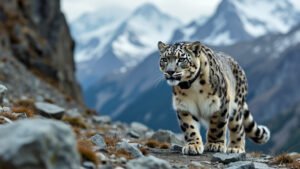Introduction
Tracking snow leopard movements in the wild is crucial for understanding their behavior, habitat use, and conservation needs. This article delves into the various technologies and methods researchers use to monitor these elusive big cats
We will explore the use of GPS collars, camera traps, and field observations, the procedures for attaching tracking devices, the types of data collected, and how this information is analyzed to aid conservation efforts. Additionally, we will discuss the challenges and ethical considerations involved in tracking snow leopards
Technology Used to Track Snow Leopards
Tracking snow leopards in the wild requires advanced technology to gather accurate and comprehensive data on their movements and behavior
Researchers employ several tools and methods to achieve this goal, including GPS collars, camera traps, and field observations. Each of these technologies plays a crucial role in the successful monitoring of these elusive predators
GPS Collars
GPS collars are one of the primary tools used in tracking snow leopards. These collars are fitted with GPS devices that transmit location data via satellites
The data collected provides precise information about the leopard’s movements, home range, and territory use. GPS collars have revolutionized wildlife tracking by offering real-time data and reducing the need for constant human presence in the field
The GPS collars used on snow leopards are designed to be lightweight and durable, ensuring minimal impact on the animal’s natural behavior
Researchers can program the collars to collect data at specific intervals, such as every few hours, which helps in understanding movement patterns and daily activities. This data is crucial for identifying critical habitats, migration routes, and potential human-wildlife conflict zones
The collars typically last for several months to a few years, depending on the battery life and data transmission frequency. Once the battery depletes, the collar is designed to drop off, allowing researchers to retrieve it and analyze the collected data. This retrieval process often involves using a VHF signal emitted by the collar to locate it in the field
Camera Traps
Camera traps are another essential tool in tracking snow leopards. These motion-activated cameras are strategically placed in areas where snow leopards are likely to pass, such as trails, ridgelines, and marking sites. When a snow leopard passes by, the camera captures images or videos, providing visual evidence of their presence and behavior
Camera traps help researchers identify individual leopards through their unique coat patterns, monitor their health, and observe interactions with other wildlife. The data from camera traps complements the information obtained from GPS collars, offering a more comprehensive understanding of snow leopard ecology
In addition to tracking movements, camera traps are instrumental in estimating snow leopard populations. By analyzing the frequency and distribution of captures, researchers can make informed estimates about the density and distribution of snow leopards in a given area. This information is vital for conservation planning and assessing the effectiveness of protection measures
Field Observations
While technology plays a significant role in tracking snow leopards, field observations remain an integral part of research
Researchers and field biologists spend extensive time in snow leopard habitats, gathering direct observations and signs of leopard activity. This includes identifying tracks, scat, and other signs that indicate the presence of snow leopards
Field observations provide valuable context to the data collected from GPS collars and camera traps. For instance, understanding the terrain, vegetation, and prey availability in areas frequented by snow leopards helps researchers interpret movement patterns and habitat preferences
Additionally, fieldwork allows researchers to assess potential threats, such as poaching or habitat degradation, and take appropriate conservation actions
Fieldwork also involves engaging with local communities and involving them in conservation efforts. Local knowledge and cooperation are essential for the success of tracking and conservation programs. By working closely with communities, researchers can ensure the protection of snow leopards while addressing human-wildlife conflicts and promoting sustainable coexistence
Attaching Tracking Devices
Attaching tracking devices to snow leopards is a critical process that requires careful planning and execution to ensure the safety and well-being of the animals
This section explores the methods and procedures used by researchers to attach GPS collars and other tracking devices to snow leopards, highlighting the importance of safety, the equipment used, and successful case studies
Safety Procedures
Ensuring the safety of snow leopards during the collaring process is paramount. Researchers follow strict protocols to minimize stress and risk to the animals. The process typically involves several key steps:
Locating and Identifying the Target Leopard: Researchers use camera traps and field observations to identify individual snow leopards that need to be collared. This helps ensure that the correct animal is targeted and reduces unnecessary captures
Sedation: Once a target leopard is identified, it is safely sedated using a dart gun. Veterinarians and trained wildlife biologists handle the sedation process, carefully monitoring the leopard’s vital signs to ensure it remains stable throughout
Attaching the Collar: After the leopard is sedated, researchers quickly and efficiently attach the GPS collar. The collar is designed to fit comfortably without hindering the animal’s movement or behavior. Researchers check the fit and function of the collar before proceeding
Health Assessment: While the leopard is sedated, researchers conduct a thorough health assessment. This includes checking for injuries, parasites, and overall physical condition. Blood and tissue samples may be collected for further analysis
Monitoring Recovery: After the collar is attached, the sedation is reversed, and the leopard is monitored until it fully recovers and can safely return to its natural behavior. Researchers stay with the animal until it is clear that it has regained full consciousness and mobility
Equipment Used
The equipment used in tracking snow leopards is specifically designed to be effective and humane. This includes:
GPS Collars: These collars are lightweight, durable, and weather-resistant. They are equipped with satellite transmitters that send location data at pre-set intervals, providing continuous tracking information
VHF Transmitters: In addition to GPS, many collars include VHF transmitters. These emit radio signals that researchers can track using a receiver, helping locate the leopard if the GPS signal is lost or the collar falls off
Sedation Equipment: Dart guns and tranquilizers are used to safely sedate the leopards. These tools are handled by trained professionals to ensure precise and humane administration
Monitoring Devices: Heart rate monitors, thermometers, and other medical equipment are used to monitor the leopard’s vital signs during the sedation process, ensuring its safety
Success Stories
Numerous successful tracking projects have provided invaluable insights into snow leopard behavior and ecology. Here are a few notable examples:
Mongolia’s Tost Mountains: In this region, researchers have successfully collared several snow leopards, revealing critical information about their home range, hunting patterns, and interactions with other wildlife. The data collected has helped establish protected areas and improve conservation strategies
Kyrgyzstan’s Sarychat-Ertash Reserve: This project has tracked snow leopards for over a decade, yielding data on population dynamics, prey preferences, and migration routes. The information has been instrumental in developing anti-poaching measures and engaging local communities in conservation efforts
India’s Spiti Valley: Here, researchers have used GPS collars to study snow leopards’ adaptation to changing environmental conditions, such as climate change and habitat fragmentation. The findings have informed policies on land use and wildlife protection
Data Collection and Analysis
Data collection and analysis are crucial components in tracking snow leopards. The information gathered from tracking devices helps researchers understand snow leopard behavior, habitat use, and interactions with the environment
This section explores the types of data collected, methods of analysis, and how these insights contribute to conservation efforts
Types of Data Collected
Tracking snow leopards involves collecting various types of data to gain a comprehensive understanding of their lives in the wild:
Location Data: GPS collars provide precise location points, allowing researchers to map the movements and home ranges of individual snow leopards. This data reveals patterns in habitat use, territorial boundaries, and migration routes
Activity Data: Some collars are equipped with accelerometers that record the animal’s activity levels. This helps researchers distinguish between different behaviors, such as resting, hunting, or traveling
Health Data: During the collaring process, researchers collect health-related data, including body condition, weight, and samples for genetic and disease analysis. This information is critical for assessing the overall health of the population
Environmental Data: Camera traps and field observations complement the data from collars by providing context on the snow leopards’ environment. This includes information on prey availability, vegetation types, and potential threats such as human encroachment or livestock presence
Data Analysis Methods
Analyzing the collected data involves several sophisticated techniques to extract meaningful insights:
Spatial Analysis: Using Geographic Information Systems (GIS), researchers analyze the spatial data to identify key habitats, movement corridors, and areas of high activity. This helps in understanding habitat preferences and identifying critical areas for conservation
Behavioral Analysis: By examining activity patterns and movement data, researchers can infer behavioral patterns such as hunting strategies, resting sites, and interactions with other snow leopards or wildlife
Population Modeling: Combining data from multiple individuals, researchers create models to estimate population size, density, and dynamics. This is vital for assessing the status of the snow leopard population and predicting future trends
Threat Assessment: Data on snow leopard movements and behavior can highlight potential threats, such as areas with high human activity or livestock presence. This information guides the development of mitigation strategies to reduce human-wildlife conflict
Conservation Insights
The insights gained from tracking data are invaluable for snow leopard conservation:
Habitat Protection: Understanding where snow leopards live and move helps identify critical habitats that need protection. This information is used to design protected areas and wildlife corridors that ensure the survival of the species
Human-Wildlife Conflict Mitigation: Tracking data reveals areas where snow leopards come into contact with human activities, such as livestock grazing. This helps develop strategies to minimize conflicts, such as improved livestock management practices or community-based conservation programs
Climate Change Adaptation: By studying how snow leopards use different habitats and respond to environmental changes, researchers can predict how climate change might impact them. This information is crucial for developing adaptive conservation strategies to ensure the long-term survival of snow leopards
Policy Development: Data-driven insights inform national and international conservation policies. Governments and conservation organizations rely on this information to make informed decisions about land use, wildlife protection, and resource allocation
Challenges and Ethical Considerations
Tracking snow leopards involves numerous challenges and ethical considerations that researchers must navigate to ensure both the effectiveness of their work and the welfare of the animals
This section discusses the difficulties faced in tracking snow leopards, the ethical concerns involved, and the solutions and improvements that help address these issues
Tracking Difficulties
Tracking snow leopards is inherently challenging due to their elusive nature and the harsh environments they inhabit:
Remote and Rugged Terrain: Snow leopards live in some of the most remote and inaccessible mountainous regions in the world, such as the Himalayas and the Tibetan Plateau. The rugged terrain and extreme weather conditions make it difficult for researchers to reach these areas and conduct fieldwork
Low Population Density: Snow leopards have large home ranges and low population densities, which means that individuals are spread out over vast areas. This makes it challenging to locate and monitor them consistently
Technical Limitations: The technology used for tracking, such as GPS collars and camera traps, can face limitations in remote areas. For example, GPS signals may be obstructed by steep mountains, and camera traps may be difficult to maintain in harsh weather conditions
Ethical Concerns
Ethical considerations are paramount in wildlife research, especially when dealing with endangered species like snow leopards:
Animal Welfare: The process of capturing and sedating snow leopards to attach tracking devices must be done with utmost care to minimize stress and potential harm. Ensuring the physical and psychological well-being of the animals is a primary concern
Informed Consent: While animals cannot provide informed consent, ethical research practices involve minimizing invasiveness and ensuring that the benefits of the research outweigh any potential harm to the animals
Data Security: The data collected from tracking devices must be handled responsibly to prevent misuse. For example, location data should be protected to avoid poachers gaining access to the whereabouts of snow leopards
Solutions and Improvements
Researchers have developed several strategies to overcome the challenges and address ethical concerns in tracking snow leopards:
Advanced Technology: Innovations in tracking technology, such as more reliable and longer-lasting GPS collars and more resilient camera traps, help improve data collection in remote and harsh environments. Newer models of collars are designed to be less intrusive and more comfortable for the animals
Non-invasive Methods: Whenever possible, researchers use non-invasive methods like camera traps and scat analysis to gather data without the need for capturing and handling the animals. This reduces stress and potential harm
Community Involvement: Engaging local communities in conservation efforts is crucial. Local people can provide valuable knowledge about snow leopard behavior and movements, assist in setting up and maintaining tracking equipment, and help in monitoring the animals. This approach not only aids research but also fosters a sense of stewardship among local populations
Strict Protocols: Adhering to strict ethical protocols and guidelines, such as those set by wildlife conservation organizations and research institutions, ensures that animal welfare is prioritized. Regular training for field researchers on humane handling and monitoring techniques is essential
Data Protection: Implementing robust data security measures ensures that sensitive information, such as the location of snow leopards, is protected from potential misuse. Only authorized personnel should have access to this data
Conclusion
Tracking snow leopards in the wild is a complex but essential task for understanding and conserving this elusive species. Through advanced technologies like GPS collars, camera traps, and meticulous field observations, researchers gather critical data on snow leopard movements, behavior, and habitat use
The process of attaching tracking devices is conducted with strict safety protocols to ensure the well-being of the animals, while the collected data provides invaluable insights for conservation efforts. Researchers face significant challenges, including remote and rugged terrains and ethical considerations, but ongoing advancements in technology and methods, along with community involvement, offer effective solutions
The information derived from tracking snow leopards guides the development of conservation strategies aimed at protecting these majestic creatures and their habitats, ensuring their survival for future generations










